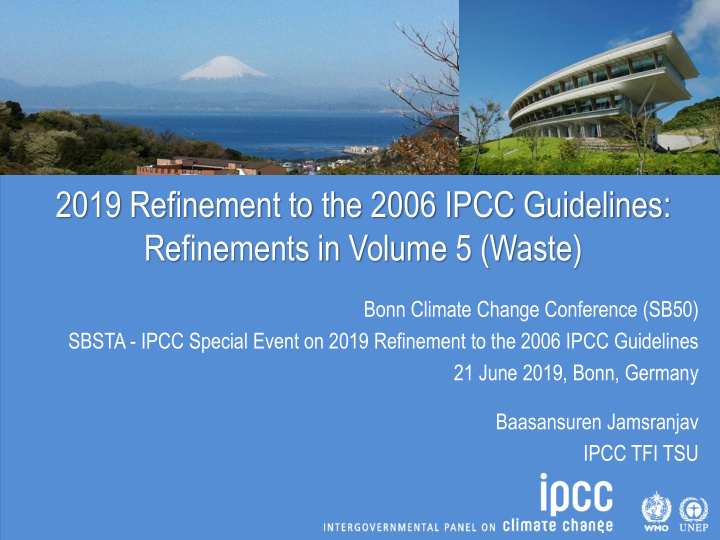



2019 Refinement to the 2006 IPCC Guidelines: Refinements in Volume 5 (Waste) Bonn Climate Change Conference (SB50) SBSTA - IPCC Special Event on 2019 Refinement to the 2006 IPCC Guidelines 21 June 2019, Bonn, Germany Baasansuren Jamsranjav IPCC TFI TSU
Outline Overview Major refinements Summary
Overview • Refinements are made in the following chapters: Chapter 2: Waste generation, composition and management data Chapter 3: Solid waste disposal Chapter 5: Incineration and open burning of waste Chapter 6: Wastewater treatment and discharge • Volume 5 contains annexes: Annex 1 (Mapping tables) Annex 2 (Worksheets) • IPCC Waste Model for estimation of methane (CH 4 ) emissions from solid waste disposal site (SWDS) has been updated reflecting the refinements made in relevant chapters. • The refinements are made to include new and updated default data as well as new and up-to-date information and guidance, among others.
Chapter 2: Waste generation, composition and management data • Updated and new default data on waste generation and treatment e.g., new data on municipal solid waste (MSW) open dumped (updated Table 2.1 and updated Annex 2A.1) • Updated and new default data on MSW composition e.g., new data on garden waste and nappies (updated Table 2.3 and new Annex 2A.2) • New default data on carbon (C) and nitrogen (N) content in domestic and industrial sludge (new Table 2.4a) • New and updated default data on degradable organic carbon (DOC) content in domestic and industrial sludge (new Table 2.4a) • Updated/elaborated guidance on sludge e.g., definition of sludge; DOC of sludge (Section 2.3.2)
Chapter 3: Solid waste disposal • New types of managed SWDS and respective default methane correction factors (MCF) (updated Table 3.1) Managed poorly – semi-aerobic Managed well – active aeration Managed poorly – active aeration
Chapter 3: Solid waste disposal • New default data on fraction of degradable organic carbon which decomposes (DOC f ) by type of waste (new Table 3.0): Less decomposable (e.g., wood, tree branches) Moderately decomposable (e.g., paper, textile, nappies) Highly decomposable (e.g., food waste, grasses) • Appendices provide information as basis for future methodological development: Information on nitrous oxide (N 2 O) emissions from SWDS (Appendix 3A.1) Information on estimation of CH 4 emissions from SWDS managed by active aeration using locally available measured data (Appendix 3A.2)
Chapter 5: Incineration and open burning of waste • New technologies of thermal treatment of waste: pyrolysis, gasification and plasma (Section 5.1) • New default emission factors for CH 4 and N 2 O emissions from combined systems of pyrolysis-melting and gasification-melting (new Tables 5.3a and 5.4a) • Updated default oxidation factor for opening burning of MSW (updated Table 5.2)
Chapter 6: Wastewater treatment and discharge The chapter has been substantially refined: • Updated and elaborated guidance Introduction (Section 6.1) CH 4 emissions from wastewater (Section 6.2) N 2 O emissions from domestic wastewater (Section 6.3) • New guidance N 2 O emissions from industrial wastewater (Section 6.4) • New and updated default data • Annexes (Annex 6A.1- 6A.7) provide additional details related to new or updated default data • Information on non-biogenic CO 2 emissions from wastewater treatment as basis for future methodological development (Appendix 6A.1)
Chapter 6: Wastewater treatment and discharge Introduction (Section 6.1) Figure 6.1 has been updated and simplified to show different pathways for wastewater treatment and discharge New subsections have been added to discuss Centralized treatment systems (Section 6.1.1) Decentralized treatment systems of domestic wastewater (onsite sanitation) (Section 6.1.2) Emissions from receiving waters (Section 6.1.3)
Chapter 6: Wastewater treatment and discharge CH 4 emissions from wastewater (Section 6.2) Certain MCFs for domestic and industrial wastewater treatment and discharge have been updated (e.g., septic systems; centralized wastewater treatment plants; discharge to aquatic environments) There are no longer separate MCFs for “well managed” and “not well managed” centralized aerobic treatment systems New Tier 2 MCFs/emission factors for wastewater discharged to aquatic environments (discharge to reservoirs, lakes and estuaries; discharge to aquatic environments other than reservoirs, lakes and estuaries) New guidance on the calculation of organic component removed as sludge
Chapter 6: Wastewater treatment and discharge N 2 O emissions from domestic wastewater (Section 6.3) Updated guidance on estimation of N 2 O emissions from wastewater treatment plants Updated and new emission factors for discharges to aquatic environments Updated emission factor for wastewater treatment plants New emission factor for septic systems
Chapter 6: Wastewater treatment and discharge N 2 O emissions from industrial wastewater (new Section 6.4) New guidance ( no methodology in the 2006 IPCC Guidelines ) Emissions from industrial wastewater treatment plants Emissions from industrial wastewater effluent discharged to aquatic environments
Summary Volume 5 of the 2019 Refinement provides: • Updated and elaborated guidance (e.g., new types of managed solid waste disposal sites; CH 4 and N 2 O emissions from gasification and pyrolysis of waste; CH 4 and N 2 O emissions from wastewater) Better understanding of emissions/sources and more clearer guidance (e.g., clarification to the existing guidance) • New guidance (e.g., N 2 O emissions from industrial wastewater) Improved completeness • New and updated default data (e.g., waste generation and composition; parameters of domestic and industrial sludge; CH 4 and N 2 O emissions from domestic and industrial wastewater treatment and discharge) Improved accuracy
Thank you https://www.ipcc-nggip.iges.or.jp/ https://www.ipcc-nggip.iges.or.jp/public/2019rf/index.html
Recommend
More recommend